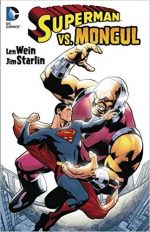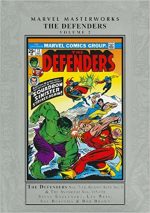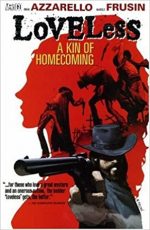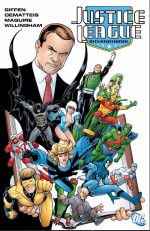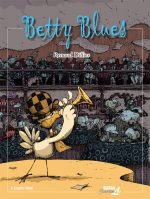

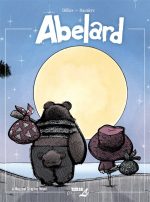
By Renaud Dillies & various translated by Joe Johnson (NBM/ComicsLit)
Pack ISBN: 978-1-68112-106-2
Renaud Dillies belongs to that cool school of European artists who are keenly aware of the visual power imbued by using anthropomorphic characters in grown up stories – a notion we’ve all but lost here in Britain, and one primarily used for kiddie comics and pornography in the USA and Asia.
Dillies was born in Lille in January 1972, the inveterate dreamer, artist and storyteller in a brood of five kids. Music was a big part of his parents’ lives: British Pop – especially The Beatles and John Lennon – and Jazz: mostly Big Band, Swing and Satchmo. The impressionable lad listened, learned and inwardly digested…
After college – studying Humanities, Graphic and Decorative arts at Saint-Luc School of Fine Arts in Tournai – Dillies began his comics career, like so many others, at Spirou. He drew backgrounds for prolific cartoonist Frédéric Jannin (Rockman, Germain et Nous and many more) whilst also inking Frédéric “Clarke†Seron on sublime sorceress comedy Mélusine.
The young creator soon blended his twin passions for comics and music in his first solo work. Betty Blues – published by Paquet in 2003 – consequently took the “Best Debut†award at that year’s Angoulême Comics Festival.
He followed up with Sumato, Mister Plumb (with Régis Hautière) and Mélodie du Crépuscule (Melody of Twilight) before switching to publisher Dargaud in 2009. Here he devised Bulles et Nacelle ably assisted by colour artist Christophe Bouchard (available in English and reviewed below as Bubbles and Gondola) and, in 2011, created Abélard (again with Hautière and also available in translation from NBM/ComicsLit, as well as part of this gift-set package.
During this period Dillies still toiled as a jobbing Bande Dessinée creator. Under the pen-name “Jack†he drew comedy sports features Les Foot Maniacs and Tout sur le Rugby for Bamboo and illustrated some of Arboris’ erotic short stories for the series Salut les coquinas.
With three of the very best of these eccentrically exotic confections now available in a supremely economical shrink-wrapped gift-set, you’d be crazy to not make the acquaintance of such a scintillating scribe/scribbler…
Betty Blues
Coming from the same dark place and cultural wellsprings as Benoît Sokal’s wry, bleak and witty Inspector Canardo detective duck tales, Betty Blues is both paean and elegy to the unholy trinity of Modern Cool and Shattered Idealisms: Noir, Jazz and Lost Love, all focused through the mythologising lens of cinematic Fifties Americana.
The tragic, flawed star of this intoxicating fable is Little Rice Duck, possibly the greatest bird ever to blow a trumpet in the seedy clubs and wild environs of the West Wood. Starring at the nightspots and making music are his life, but his hot girlfriend Betty is getting pretty tired playing second fiddle to his art.
She’s a pretty bird who needs lots of Loving Attention, the Good Life and Expensive Champagne, so on yet one more tedious night when Rice is deep in the spotlight blowing hot and loud, she calamitously listens to an unctuous, sleazy fat cat at the bar who offers her plenty of all three before sneaking off with him…
Her disappearance hits Rice as hard as he subsequently hits the bottle, and his all-too-late regrets shake him to the core. Going downhill fast, the despondent and always-angry little guy throws his magnificent trumpet – the thing which has cost him true love – off a high bridge and hops a train heading “anywhere but hereâ€â€¦
The hurtling horn hits a boat-riding sap and thus begins to affect the lives of a succession of other poor schnooks whilst, elsewhere uptown, Betty begins to reconsider her hasty decision as the downsides of being a rich guy’s trophy – or pet – start becoming apparent…
For Rice, the end of the line finds him deep in a forested nowhere-land dubbed “Kutwood†where he is befriended by the owl Bowen who is both lumberjack and radical environmental terrorist.
Slowly the broken musician is drawn into the affable agitator’s world of violence, sabotage and anti-capitalist polemic, but all he is really thinking about during so many late-night conversations is the tatty old trumpet nailed high up out of reach on Bowen’s cabin wall…
And Jazz: sweet, hot Jazz music…
Back in the city Betty starts to fear for life, soul and sanity on the chubby arm of her mercurial plutocrat-cat, as the portentous trumpet begins to reshape the lives of many ordinary folk innocent and venal. And then one day Betty meets an old friend of Rice’s who tells her he’s gone missing…
Sad, grim, brooding and surprisingly suspenseful, this captivating riff on complacency, ill-considered aspirations and lost chances is beguilingly constructed and subtly realised, with a smart undercurrent of bleakly cynical humour counter-pointing the Noir flavour and motif of inescapable doom.
Betty Blues will delight mature readers with a well-honed sense of the absurd and an abiding taste for the dark…
Bubbles and Gondola
A penetrating examination of the creative urge and the price of following a muse, Bubbles and Gondola follows the strivings of a mouse named Charlie who is gripped by an insatiable hunger to write great things. To better accomplish this, the mouse resides in a bleak windy garret in splendid isolation, ignoring the distractions of the world, and spending his brief moments of down-time strumming his guitar.
He constantly reminds himself that “solitude is cool†but as a crippling writer’s block increasingly torments him and the outside world insufferably impinges on his tortured brooding, Charlie’s views begin to imperceptibly shift.
That sense of change intensifies after a small blue bird named Mister Solitude starts to repeatedly show up uninvited. The debilitating ennui seems to abate – just a bit – and the author even leaves his lonely den on occasion just to watch a festival or dine with family… However, the unwanted but comforting creature eventually becomes a casualty of the writer’s creative frustration and vanishes after a bitter clash in the attic. Conflicted and inexplicably bereft, Charlie seeks help for his avian companion, but cannot find his solitude anymore. The mouse is compelled to search high low for his supposedly unwanted comrade, embarking on a life -changing odyssey…
A beguiling argosy and visual tour de force allegorically challenging preconceptions about work-life balance and simple human companionship, Bubbles and Gondola is a delicious treat tinged with bittersweet revelation.
Abelard
Far more poignant and concealing a far more painful message, Abelard is ostensibly a simple fable of unrequited love in simpler times. The eponymous hero is an impressionable young chick living in a swampy backwater. He has a hat which grants him a prophetic epigram every day, but other than that he is quite unremarkable.
The little lad’s life changes forever when a group of rich city types in search of good fishing briefly vacation in the morass he calls home. Although she barely notices him, Abelard’s meeting with the so-sophisticated Eppily sets the poor young fool on a path he cannot escape…
Her companions seal his fate by trying to let the lovesick fool down easily. Fyodor warns the chick that girls like Eppily can only be seduced by those who offer her the moon or suchlike. Abelard has never heard of a metaphor…
Determined to win his true love, buy unable to supply the goods, the little dreamer hears the older swamp inhabitants discussing the news from America. Two ingenious fellows have invented a flying machine. That’s Americans for you: before long they’ll be wanting to go to the moon…
With love as his spur and a suitably encouraging message from his hat, Abelard turns away from the swamp and starts walking westward…
His patient peregrinations bring him into the company of a band of gypsy performers and he shares their life and the painful prejudice they endure. Eventually he leaves them, unwilling to accept the reading of the heartbroken fortune-teller who peers into his tomorrows…
A lonely nomad, he goes into a bar and meets a bitter, broken, belligerent bear. Foul-mouthed surly scrapper Gaston has seen it all, hates everyone and has nothing but bile for the entire world.
He, too, once knew an Eppily…
Against all odds the old warrior and untutored waif implausibly unite and head for America together, taking ship on a migrant vessel where fate plays the cruellest trick on them…
Ultimately both travellers get to fulfil their dreams, but not in way they ever expected or wanted…
Beautiful, moving and eternally optimistic in the face of crushing experience, Abelard philosophically examines the unrelenting trials of life and demonstrates the power of hope and poetic idealism against insurmountable odds.
This trio of anthropomorphic tales comprise a masterclass in graphic narrative used to explore the nature of humanity: offering pride, wonder, resilience and heart as an antidote to the worst reality can challenge us with. They are also stunning lovely to look at and every fan of art or storytelling should see so for themselves.
Betty Blues © 2003 Editions Paquet. English translation © 2013 NBM.
Bubbles and Gondola © 2009 by Dillies – Dargaud Benelux. English translation © 2011 NBM.
Abelard © – 2011 Dillies – Hautière – Dargaud Benelux. English translation © 2012 NBM.


